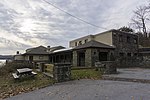Fort Montgomery (Hudson River)
American Revolution on the National Register of Historic PlacesAmerican Revolutionary War fortsAmerican Revolutionary War museums in New York (state)Forts in New York (state)Forts on the National Register of Historic Places in New York (state) ... and 11 more
Government buildings completed in 1776Highlands, New YorkHudson RiverInfrastructure completed in 1776Museums in Orange County, New YorkNational Historic Landmarks in New York (state)National Register of Historic Places in Orange County, New YorkNew York (state) historic sitesParks in Orange County, New YorkRuins in the United StatesU.S. Route 9W

Fort Montgomery was a fortification built on the west bank of the Hudson River in Highlands, New York by the Continental Army during the American Revolution. Erected in 1776, Fort Montgomery was one of the first major investments by the Americans in strategic construction projects. Declared a National Historic Landmark, it is part of the Hudson River Valley National Heritage Area, owned and operated by the state of New York as the Fort Montgomery State Historic Site.
Excerpt from the Wikipedia article Fort Montgomery (Hudson River) (License: CC BY-SA 3.0, Authors, Images).Fort Montgomery (Hudson River)
Twin Forts Trail, Town of Highlands
Geographical coordinates (GPS) Address Nearby Places Show on map
Geographical coordinates (GPS)
| Latitude | Longitude |
|---|---|
| N 41.323888888889 ° | E -73.986944444444 ° |
Address
Fort Montgomery
Twin Forts Trail
10922 Town of Highlands
New York, United States
Open on Google Maps










